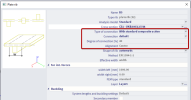Definition of composite beams
Composite beams are to be defined as standard plate ribs. They may also be created using a ribbed plate 2D member, which includes the definition of the ribs. A few properties will then specify the beam as composite.
| Type of connection |
this property is visible only when the CAM is enabled. There are 4 possible values: with standard composite action applies a composite cross-section to the plate rib without eccentricity on the 1D member; this has the advantage that it does not create parasite axial forces in the model; for details "Composite Analysis Model - Theoretical background" with advanced composite action uses a standard eccentric plate rib, without adjustment of the cross-section; the composite effect is taken into account directly through the real eccentricity of the 1D member in the finite element model; this will, however, generate axial forces in both the beam and the deck without composite action assumes that there is no longitudinal shear connection between the beam and the deck; it is taken into account by means of a plate rib without eccentricity using the selected beam cross-section without adjustment user-defined eccentricity corresponds to a standard plate rib; it will not allow using composite functionalities on that beam; additionally, any plate rib linked to a non-composite deck will use this setting |
| Connection |
this property is visible only for a type of connection with standard composite action; it allows to define the degree of shear connection between the beam and the deck. The possible values are: default: the actual connection type is defined in the composite setup full: this assumes a perfect shear connection between the beam and the deck partial: this assumes a partial connection between the beam and the deck |
| Degree of connection |
this property is visible only for a type of connection with standard composite action; it defines the actual degree of connection between the beam and the deck. Only in case of a partial connection, the degree of connection may be defined here. Otherwise, this property is read-only. The default value of the degree of connection is defined in the composite setup. |
| Alignment |
For all composite types of connection, the alignment is read-only and configured automatically according to the selected type of connection. It is centreed for standard and without composite action; it is bottom for advanced composite action. For user-defined eccentricity, the alignment is defined by the user. |
Effective Width
Effective width is a standard property of plate ribs in SCIA Engineer. It is used for several purposes in a usual analysis model. There are two sets of values defining the effective width of a plate rib:
- internal forces effective width is used for integrating stresses from the plate during output of internal forces in the rib (in 1D internal forces result service, when ticking the option rib/integration strip)
- check effective width defines the width of the plate part that will be taken into account in the checks to calculate the resistance of the cross-section (code dependent)
It is important to note, that none of the above affects the stiffness of the system. Modifying the effective width does not modify the properties of the cross-sections in the analysis model.
There is however an important difference when using the Composite Analysis Model, which uses the effective width in a third way:
- internal forces effective width is taken into account when calculating the stiffness of the composite cross-section of a beam defined with standard composite action; for details, see "Composite Analysis Model - Theoretical background"
- in case of beam without composite action, all effective width properties are set to zero
Important: unlike in all other cases, in a plate rib with standard composite action, the effective width affects the stiffness of the beam
The effective width of a plate rib may be defined manually or automatically. Available properties can be found in " Rib in the slab".
Detailed information about the automatic calculation of effective width can be found in "Automatic calculation of the effective width of plate ribs"

